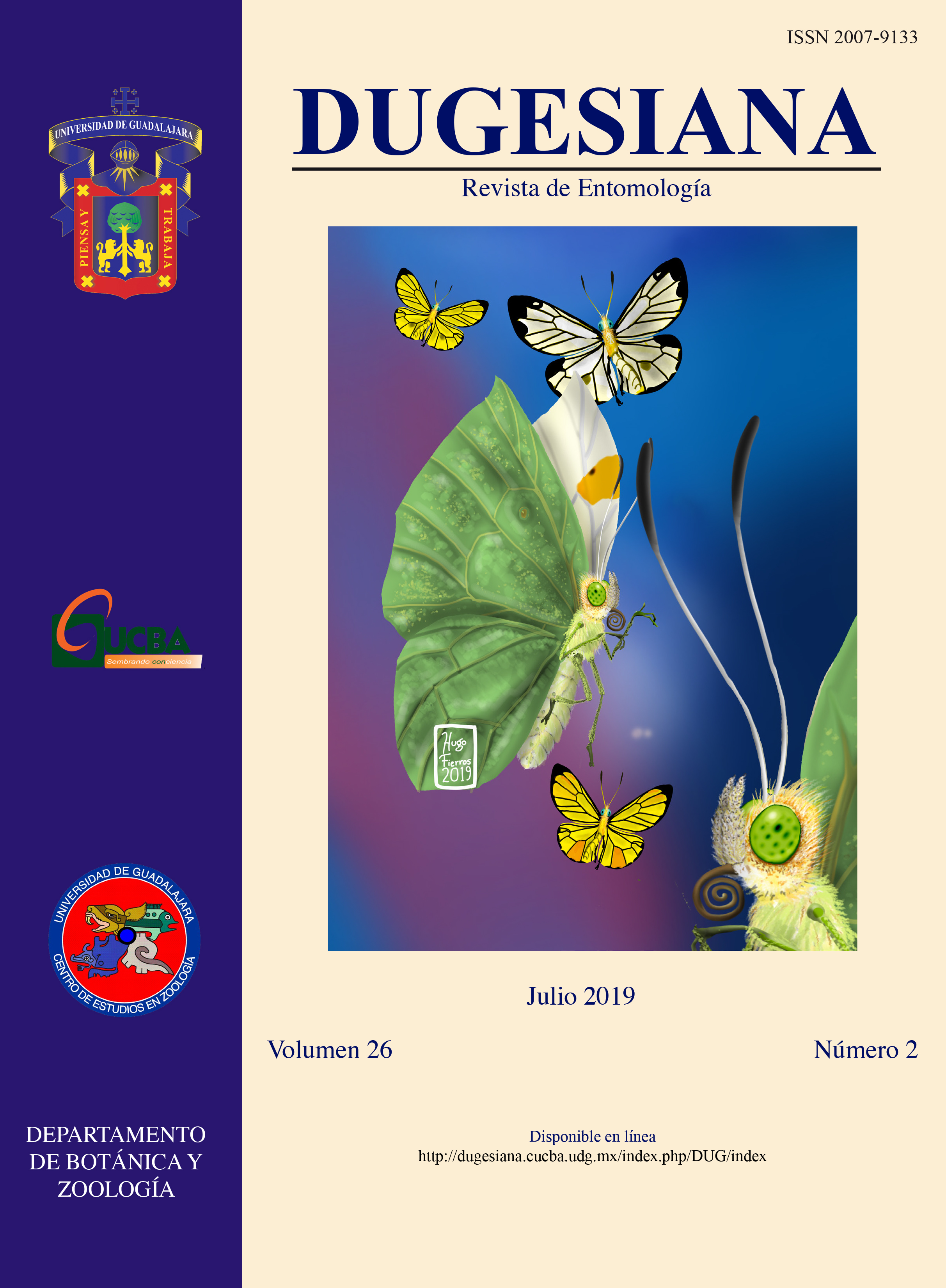Primer registro de pseudoescorpiones (Arachnida: Pseudoscorpiones) de Guanajuato, México
DOI:
https://doi.org/10.32870/dugesiana.v26i2.7077Keywords:
Taxonomía, Pseudoescorpionida, GuanajuatoAbstract
En el presente trabajo se dan a los conocer los primeros registros de pseudoescorpiones para el estado de Guanajuato, se encontraron a cuatro especies de tres familias: Microbisium parvulum (Neobidisiidae), Serianus dolosus (Garypinidae), Parachernes ca robustus y Hesperochernes sp. (Chernetidae). Los dos primero se obtuvieron en trampas de caída, el tercero en nidos de Neotoma mexicana y el cuarto debajo de piedras. Además se establece la relación forética entre Parachernes y N. mexicana.References
Benedict, E. M. and D. R. Malcolm. 1977. Some garypoid false scorpions from western North America (Pseudoscorpionida: Garypidae and Olpiidae). The Journal of Arachnology; 5 (2):113-132.
Chamberlin, J. C. 1931. The arachnid order Chelonethida. Stanford University Publications, Biological Sciences; 7(1):1-284.
Ceballos, A. 2004. Pseudoscorpionida, (pp. 417-429). In: J. E. Llorente-Bousquets, J. J. Morrone, O. Y. Ordóñez y I. V. Fernández (Eds.), Biodiversidad, taxonomía y biogeografía de Artrópodos de México: hacia una síntesis de su conocimiento. Vol. 4. Facultad de Ciencias, UNAM, CONABIO, México.
Cuevas-Carrillo, J. I. y M. Zorrilla. 2012. Localización y superficie. (pp. 28-37) In: La Biodiversidad en Guanajuato: Estudio de Estado vol. I. Conabio (Eds.). Comisión Nacional para el Conocimiento y Uso de la Biodiversidad (CONABIO) Instituto de Ecología del Estado de Guanajuato (IEE). Distrito Federal, México.
Cruz Angún, A., R. Becerril Patlán y O. Báez Montes 2012. Introducción, (pp. 13-25). In Conabio (eds) la Biodiversidad en Guanajuato: Estudio de Estado vol. I. México. Comisión Nacional para el Conocimiento y Uso de la Biodiversidad (CONABIO) Instituto de Ecología del Estado de Guanajuato (IEE). Distrito Federal, México.
Francke, O. F. 2014. Diversidad de Arthropoda (Chelicerata:Arachnida ex Acari) en México. Revista Mexicana de Biodiversidad, Supl. 85:S408-S418.
Francke, O. F. and G. A.Villegas-Guzmán. 2006. Symbiotic relationships between pseudoscorpions (Arachnida)and packrats (Rodentia). Journal of Arachnology, 34,289-298.
Harvey, M. 2002. The neglected cousins: What do we know about the smaller arachnid orders?. The Journal of Arachnology; 30(2):357-372.
Harvey, M. 2013. Pseudoscorpions of the World, version 3.0. Western Australian Museum Perth. Http://www.museum.wa.gov.au/catalogues/pseudoescorpions. Consultado 2 marzo2018
Hoff, C. C. 1946. New pseudoescorpions, chiefly Neotropical of the suborder Monosphyronida. American Museum Novitates; (1318):1-32.
Hoff, C.C. 1949. The pseudoscorpions of Illinois. IIlinois Natural History Survey Buletin; 24, 409-498.
Hoff, C. C. 1956. Diplosphyronid pseudoscorpions from New Mexico. American Museum Novitates; (1780):1-49.
Kury, A. B. and J. C. Cokendolpher. 2000. Opiliones.(pp. 137-157). In: J. E. Llorente-Bousquets, E.
GonzálezSoriano y J. J. Morrone (Eds.), Biodiversidad,taxonomía y biogeografía de Artrópodos de México:hacia una síntesis de su conocimiento. Vol. 3. Facultad de Ciencias, UNAM, CONABIO, México.
Montiel-Parra, G., D. R. Guerrero-Fuentes, J. A. CruzLópez y O. F. Francke. 2012. Estado actual del acervo de opiliones (Arachnida: Opiliones) en la Colección Nacional de Arácnidos del Instituto de Biología, UNAM. Entomología Mexicana, 11: 100-104.
Muchmore, W. B. 1971. Phoresy by North and Central American pseudoscorpions. Proceedings of the
Rochester Academy Science, 12(2):77-97
Nelson, S. Jr. 1984. The pseudoscorpion genus Microbisium in North and Central America (Pseudoecorpionida: Neobissidae). The Journal of Arachnology; 12(3):341-350.
Pérez, T. M., C. Guzmán-Cornejo, G. Montiel-Parra, R. Paredes-León y G. Rivas. 2014. Biodiversidad de
ácaros en México. Revista Mexicana de Biodiversidad, Spl. 85: S399-S407.
Ponce Saavedra, J y O. F. Francke. 2013. Actualización taxonómica sobre los alacranes del Centro Occidente de México. Dugesiana, 20(2):73-79
Silva-Briano, M., A. Adabache-Ortiz y G. Gómez-Torres. 2010. Introducción al conocimiento de los pseudoescorpiones del estado de Aguascalientes. Investigación y Ciencia de la Universidad Autónoma de Aguascalientes, 50:5-9.
Semarnat. 2013. Informe de la situación del medio ambiente en México. Compendio de estadística ambientales. Indicadores clave y de desempeño ambiental edición 2012. México.
Villegas-Guzmán, G. A: 2015. Pseudoscorpiones (Arachnida: Pseudoscorpiones) de la Ciudad de México
y sus alrededores. Entomología mexicana, 2:76-81
Villegas-Guzmán, G. A., y T. M. Pérez. 2005. Pseudoescorpiones (Arachnida: Pseudoscorpionida) asociados a nidos de ratas del género Neotoma (Mammalia: Rodentia) del Altiplano Mexicano. Acta Zoológica Mexicana (n. s.), 21, 63-77.
Wirth, W.W. and N. Marston. 1968. A method for mounting small insects on microscope slides in Canada balsam. Annals of the Entomological Society of America; 61(3):783-784.
Downloads
Additional Files
Published
Issue
Section
License
1. Proposed policy for open access journals
Those authors who have publications with this journal, accept the following terms:
- The authors will retain their copyright and will guarantee to the journal the right of first publication of their work, which will be simultaneously subject to the Creative Commons Recognition License, which allows third parties to share the work whenever their author is indicated and His first publication is this journal.
- Authors may adopt other non-exclusive license agreements to distribute the version of the published work (eg to be deposited in an institutional telematic file or published in a monographic volume) provided the initial publication is indicated in this journal .
Authors are encouraged and encouraged to disseminate their work through the Internet (eg in institutional telematic files or on their web page) before and during the sending process, which can produce interesting exchanges and increase appointments Of the published work. (See The effect of open access).
2. Proposed policy for journals that offer open deferred access
Those authors who have publications with this journal, accept the following terms:
- The authors will retain their copyrights and will guarantee to the journal the right of first publication of their work [SPECIFY PERIOD OF TIME], which will be simultaneously subject to the Creative Commons Recognition License that allows third parties to share the work always That its author and his first publication be indicated this journal.
- Authors may adopt other non-exclusive license agreements to distribute the version of the published work (eg to be deposited in an institutional telematic file or published in a monographic volume) provided the initial publication is indicated in this journal .
- Authors are encouraged and encouraged to disseminate their work through the Internet (eg in institutional telematic files or on their web page) before and during the sending process, which can produce interesting exchanges and increase appointments Of the published work. (See The effect of open access).




